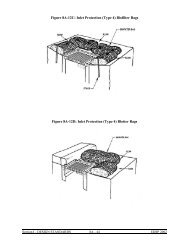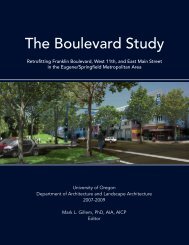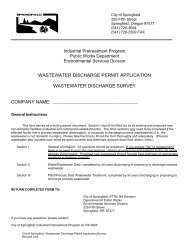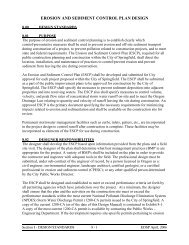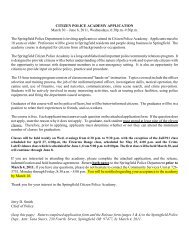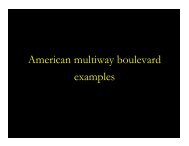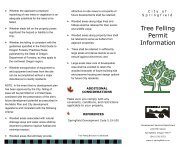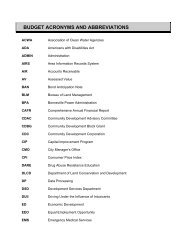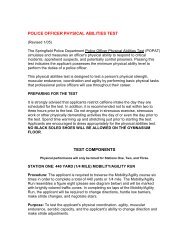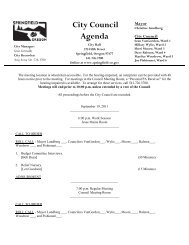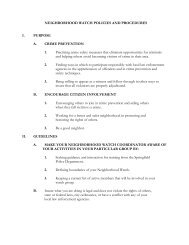Franklin Boulevard Study - City of Springfield
Franklin Boulevard Study - City of Springfield
Franklin Boulevard Study - City of Springfield
You also want an ePaper? Increase the reach of your titles
YUMPU automatically turns print PDFs into web optimized ePapers that Google loves.
Attachment A. Methodology for traffic evaluation<br />
REVISED FRANKLIN BOULEVARD STUDY EVALUATION PROCESS<br />
Attachment 1. Traffic evaluation methodology<br />
Alignment<br />
Traffic<br />
Corridor Travel Time Through-put<br />
14th Street Alignment, Multiway <strong>Boulevard</strong>, widened to north High High<br />
14th Street Alignment, Arterial, widened to north High High<br />
<strong>Franklin</strong> Alignment, Multiway Blvd., center widening Medium High<br />
<strong>Franklin</strong> Alignment, Multiway Blvd., widened to south Medium High<br />
<strong>Franklin</strong> Alignment, Arterial, center widening Medium High<br />
<strong>Franklin</strong> Alignment, Arterial, widened to south Medium High<br />
Table 1. Summary <strong>of</strong> traffic evaluation<br />
Travel speed was compared between the concepts using the corridor travel time as the<br />
performance measure:<br />
• Speed evaluation was based on the length <strong>of</strong> the alignment, as vehicle delay along<br />
the corridor is expected to be roughly equivalent between concepts.<br />
• Alignments along the existing <strong>Franklin</strong> <strong>Boulevard</strong> have an overall length<br />
approximately 4% longer than the 14 th Street alignments (.78 miles compared to .75<br />
miles).<br />
• Therefore, <strong>Franklin</strong> <strong>Boulevard</strong> alignments expected to have corridor travel times<br />
slightly longer than the 14 th Street alignments.<br />
Traffic through-put was evaluated by considering the capacity <strong>of</strong> the concepts to handle<br />
expected traffic volumes on the corridor.<br />
• All concepts include 2 through-lanes in either direction, separated BRT lanes, and<br />
bicycle facilities separated from through-travel lanes (whether in bike lanes or local<br />
access roads).<br />
• Separating BRT and bikes from the automobile travel lanes will serve to increase<br />
capacity over the existing <strong>Franklin</strong> <strong>Boulevard</strong> cross-section. Additionally, any access<br />
management/consolidation along the corridor will also increase capacity.<br />
• Consequently, total capacity <strong>of</strong> the concepts to handle through-traffic is roughly<br />
equivalent.<br />
• Expected daily traffic volumes on the corridor within the study timeframe are<br />
expected to be 35,000 vehicles or less. All <strong>of</strong> the concepts generated have sufficient<br />
capacity to handle this volume.<br />
• Any capacity problems/bottlenecks along the corridor will occur at intersections,<br />
primarily <strong>Franklin</strong>/McVay. Concept evaluation at <strong>Franklin</strong>/McVay will consider<br />
intersection capacity.<br />
PDX/PROPOSED EVALUATION FRAMEWORK MEMO V4.DOC 6



